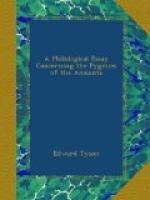“Their list of forbidden degrees
An extensive morality shows,”
since even the marriage of cousins-german is considered highly immoral. “Men and women,” says Man, “are models of constancy.” They believe in a Supreme Deity, respecting whom they say, that “although He resembles fire, He is invisible; that He was never born, and is immortal; that He created the world and all animate and inanimate objects, save only the powers of evil. During the day He knows everything, even the thoughts of the mind; He is angry when certain sins are committed, and full of pity for the unfortunate and miserable, whom He sometimes condescends to assist. He judges souls after death, and pronounces on each a sentence which sends them to paradise or condemns them to a kind of purgatory. The hope of escaping the torments of this latter place influences their conduct. Puluga, this Deity, inhabits a house of stone; when it rains, He descends upon the earth in search of food; during the dry weather He is asleep.” Besides this Deity, they believe in numerous evil spirits, the chief of whom is the Demon of the Woods. These spirits have created themselves, and have existed ab immemorabili. The sun, which is a female, and the moon, her husband, are secondary deities.
[Footnote A: The quotations from this author are taken from his work Les Pygmees. Paris, J.B. Bailliere et Fils, 1887.]
[Footnote B: Jour. Anthrop. Inst., vii.]
[Footnote C: Ibid., iv.]
South of the Andaman Islands are the Nicobars, the aborigines of which, the Shom Pen,[A] now inhabit the mountains, where, like so many of their brethren, they have been driven by the Malays. They are of small, but not pigmy stature (five feet two inches), a fact which may be due to crossing.
[Footnote A: Man, Jour. Anthrop. Inst., xviii. p. 354.]
Following the Negritos east amongst the islands, we find in Luzon the Aetas or Inagtas, a group of which is known in Mindanao as Manamouas. The Aetas live side by side with the Tagals, who are of Malay origin. They were called Negritos del Monte by the Spaniards who first colonised these islands. Their average stature, according to Wallace, ranges from four feet six inches to four feet eight inches. In New Guinea, the Karons, a similar race, occupy a chain of mountains parallel to the north coast of the great north-western peninsula. At Port Moresby, in the same island, the Koiari appear to represent the most south-easterly group; but my friend Professor Haddon, who has investigated this district, tells me that he finds traces of a former existence of Negritos at Torres Straits and in North Queensland, as shown by the shape of the skulls of the inhabitants of these regions.
The Malay Peninsula contains in Perak hill tribes called “savages” by the Sakays. These tribes have not been seen by Europeans, but are stated to be pigmy in stature, troglodytic, and still in the Stone Age. Farther south are the Semangs of Kedah, with an average stature of four feet ten inches, and the Jakuns of Singapore, rising to five feet. The Annamites admit that they are not autochthonous, a distinction which they confer upon the Mois, of whom little is known, but whose existence and pigmy Negrito characteristics are considered by De Quatrefages as established.




